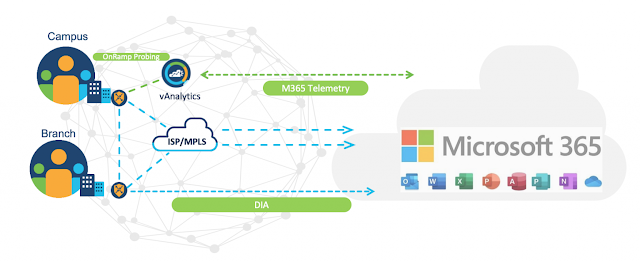Applications and cloud connectivity are the lifeblood of any enterprise today. The ability to connect users to applications reliably and securely across the remote workforce, branches, data centers, and multicloud has become a critical success factor for any organization. In a time where employees are working from home or in a hybrid work environment, reliable and secure connectivity to SaaS applications, such as Microsoft 365, is ever more important.
Applications experience poses special challenges for network teams. First and foremost is application performance. For a remote workforce or branch offices, routing user requests to SaaS applications through a centralized data center creates substantial performance impacts that include delays and latencies. Second, application optimization comes to mind. Applications, whether internally hosted or SaaS, require constant prioritization and optimization. For instance, when concurrent traffic accessing Microsoft Word and video conferencing are treated with the same parameters, optimization becomes a critical factor to ensure the quality of experience (QoE). Last, network teams often lack visibility into the performance of SaaS applications. Application issues might manifest as network issues. Service disruptions can lead to endless finger-pointing. The resulting cycles spent pinpointing the source of issues can lead to prolonged service interruptions.
Visibility and insight with network analytics
As organizations continue to embrace the internet, cloud, and SaaS, network teams are increasingly embracing analytics and visibility capabilities that result in improved application performance, faster troubleshooting, actionable business insights, and remediation. Cisco offers comprehensive analytics solutions for SD-WAN with Cisco ThousandEyes and Cisco vAnalytics.
Cisco SD-WAN is fully integrated with ThousandEyes as a turn-key solution that extends visibility into the internet, cloud, and SaaS applications for actionable insights beyond the traditional corporate network. Network teams can expedite the deployment of ThousandEyes agents from vManage to quickly pinpoint the source of issues, get to a resolution faster, and manage the performance of what matters.
Cisco vAnalytics is a powerful cloud-based analytics engine for aggregation, visualization, and analysis of SD-WAN telemetry. It is a feature-rich application that provides correlation of application behavior and QoE with the underlying SD-WAN network, translating telemetry data into visualized insights. vAnalytics is seamlessly integrated with vManage for complete management and control of the entire SD-WAN fabric.
Getting the best out of Microsoft 365
Cisco is the first SD-WAN vendor in the industry to deliver informed network routing for Microsoft 365. Leveraging real-time telemetry data from Microsoft 365 and Cisco SD-WAN Cloud OnRamp path probing data, vAnalytics dynamically correlates the baseline network performance of underlying infrastructure with Microsoft 365; proactively providing corrective suggestions when real-time metrics deviate from the operational benchmark.




















